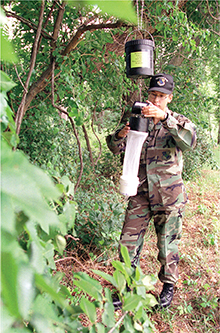Sublimation and Deposition
Directors of concerts and plays sometimes use dry ice to create a fog-like special effect. Dry ice is the common name for the solid form of carbon dioxide. At room temperature, dry ice can directly change from a solid to a colorless gas. Sublimation is the phase change in which a substance changes from a solid to a gas or vapor without changing to a liquid first. Sublimation is an endothermic change. As dry ice sublimes, the cold carbon dioxide vapor causes water vapor in the air to condense and form clouds.
Where does the name dry ice come from? Solid carbon dioxide does not form a liquid as its temperature rises. Suppose 100 steaks are shipped from Omaha, Nebraska, to a supermarket in Miami, Florida. The steaks will spoil unless they are kept cold during the trip. If regular ice is used, water collects in the shipping container as the ice melts. If the steaks are shipped in dry ice, the container and the steaks stay dry during the journey. Figure 24 shows another use of dry ice.
When a gas or vapor changes directly into a solid without first changing to a liquid, the phase change is called deposition. This exothermic phase change is the reverse of sublimation. Deposition causes frost to form on windows. When water vapor in the air comes in contact with cold window glass, the water vapor loses enough kinetic energy to change directly from a gas to a solid.
Figure 24 A technician at Tinker Air Force Base in Oklahoma hangs a mosquito trap. The trap is baited with dry ice because mosquitoes are attracted to carbon dioxide.

Section 3.3 Assessment
Reviewing Concepts
 Name six common phase changes.
Name six common phase changes. What happens to the temperature of a substance during a phase change?
What happens to the temperature of a substance during a phase change? How does the energy of a system change during a phase change?
How does the energy of a system change during a phase change? What happens to the arrangement of water molecules as water melts and freezes?
What happens to the arrangement of water molecules as water melts and freezes? What is the difference between evaporation and boiling?
What is the difference between evaporation and boiling? Explain why sublimation and deposition are classified as physical changes.
Explain why sublimation and deposition are classified as physical changes.
Critical Thinking
Applying Concepts How can the mass of a pile of snow decrease on a sunny day when the air temperature does not rise above 0°C?
Drawing Conclusions At room temperature, table salt is a solid and acetone is a liquid. Acetone is the main ingredient in nail polish remover. What conclusion can you draw about the melting points of these materials?
Writing in Science
Steps in a Process Write a paragraph describing three steps that must occur for a water molecule to start on the surface of hot bath water and end up on the surface of a bathroom mirror. Note whether the phase changes that take place during the process are endothermic or exothermic. (Hint: Use words such as first, next, and finally to show the order of events.)




